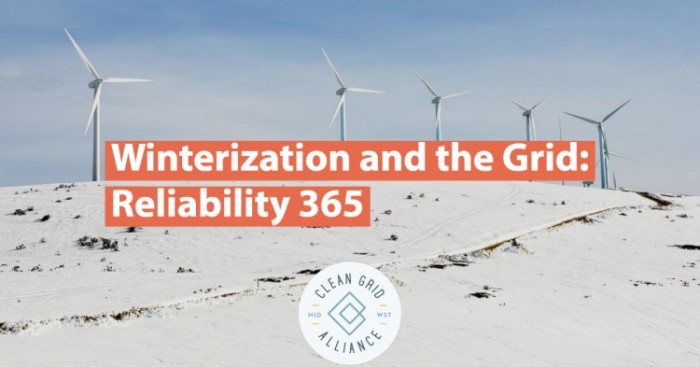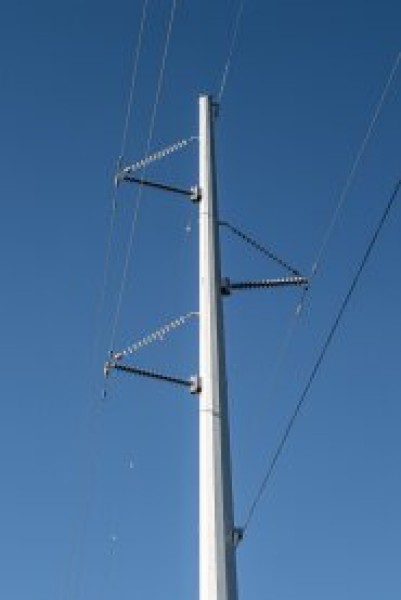Winterization and the Grid: Reliability 365
 | Madelyn Smerillo, Regional Policy Manager |

 | Madelyn Smerillo, Regional Policy Manager |
Many of the Upper Midwest states are among the coldest in the nation. Even during those times when we experience a "January thaw," temperatures in the 30s (or even 40s) are not quite warm enough to turn off the heat. Cold Midwest winters require resources that will generate a steady supply of electricity to keep our homes and businesses warm, and renewables are up to the task. Solar and wind are reliable, cost effective and efficient sources of electricity 365 days a year. Additionally, maintaining reliability requires robust transmission to deliver electricity where and when it is needed.
Generation Mix
From coal and natural gas to nuclear and renewables, the Regional Transmission Operators (RTOs or "grid operators") like MISO, PJM, SPP, ERCOT, and others, have a variety of electricity generation resources to choose from to keep the lights on all day, every day. Just as it is important to have a diverse investment portfolio to help weather the highs and lows of the economy, the same is true for maintaining the reliability of our electric grid. Renewables are a valuable addition to our energy mix, and they are already supplying clean power to 52 million homes nationwide.

However, over 60 percent of U.S. electricity generation still comes from fossil fuels. Developing more utility-scale renewables not only provides environmental and economic benefits, but contributes to diversity on the grid, helping to ensure energy reliability and keep costs low.
Solar and wind have a key advantage over other generation resources: their price tag. According to the 2021 Lazard Levelized Cost of Energy Report (LCOE), the unsubsidized cost of wind has decreased 72% and the unsubsidized cost of solar has decreased 90% since 2009. Current prices for both wind and solar are lower than any fossil fuel generation method on the market, making renewables the most financially responsible means to expand our energy mix. For the grid operator, meeting the demand for electricity is like filling a glass. The lowest cost fuel sources are deployed first, followed by other more expensive sources until the demand is met.
Transmission In addition to diversifying the energy mix, transmission is essential to maintain reliability. Since no generation method is able to function with 100 percent certainty, a robust transmission system ensures that the grid operator can deliver electricity to communities when and where they need it.
In addition to diversifying the energy mix, transmission is essential to maintain reliability. Since no generation method is able to function with 100 percent certainty, a robust transmission system ensures that the grid operator can deliver electricity to communities when and where they need it.
A variety of factors including weather patterns and open space make rural areas ideal locations for solar and wind projects. However, the demand for electricity is not as high in these areas as it is in more densely populated urban centers, which struggle to accommodate such energy infrastructure. Transmission is the "farm-to-market" road for renewable energy resources to serve high demand regions and keep communities warm all winter long.
Renewables in Winter
Various factors can interrupt the delivery of power service, including weather events. In the Midwest, delivering electricity through our coldest months is vital. And, as we saw last year in Texas, it can mean life or death. Fortunately, renewables rise to the challenge.
The cold winters can actually work to improve our generation capacity during the time of year when it is most needed.
Subscribe to our newsletter for the latest on energy & our work
In fact, wind turbines thrive in the winter. Cold temperatures increase air density,?providing a more vigorous force to push turbine blades. The wind itself is also stronger, allowing for greater amounts of power?to be?produced. This makes the Midwest an ideal location for wind projects, as the cold winters can actually work to improve our generation capacity during the time of year when it is most needed.
However, preventing ice and snow buildup on wind turbine blades is important to preserve this wintertime advantage. To keep the electricity flowing, proactive measures must be taken to winterize wind infrastructure. For example, in a winter storm, heavy precipitation can accumulate on blades, limiting generation capacity and introducing hazards from falling ice or snow buildup. To prevent this, de-icing measures are taken to ensure safety and uninterrupted electricity generation in these events. Cold weather packages employ a variety of strategies to continue electricity generation, such as using power generated by turbines to heat internal components, keeping the blades spinning and ice-free even during inclement weather.
 By design, solar power is also well-equipped for Midwest winters. Solar panels can continue to generate electricity during light snowfall. In the event of heavy snowfall, solar panel design causes snow buildup to slide off or melt quickly, allowing the panels to continue generating clean, low-cost electricity through all winter weather conditions. Even so, researchers are working on designs to further optimize solar power for winter and maximum reliability year-round.
By design, solar power is also well-equipped for Midwest winters. Solar panels can continue to generate electricity during light snowfall. In the event of heavy snowfall, solar panel design causes snow buildup to slide off or melt quickly, allowing the panels to continue generating clean, low-cost electricity through all winter weather conditions. Even so, researchers are working on designs to further optimize solar power for winter and maximum reliability year-round.
And, there's yet another benefit of using renewables especially in the winter. In colder climates like the Midwest, trees lose their leaves and the denser air moves slower as it gets colder. These factors contribute to an increase in air pollution during the winter months. Having zero-emissions fuel sources like wind and solar can help reduce the amount of carbon emissions into our atmosphere. In fact, according to the American Clean Power Association, the use of wind, solar and storage projects operating nationwide have avoided more than 327 million metric tons of carbon dioxide emissions, equivalent to taking more than 71 million cars off our roadways.
In all types of weather, renewables are reliable, low-cost energy resources that provide multiple benefits. A robust transmission system is the key to maintaining reliability and delivering our Midwest renewable energy.